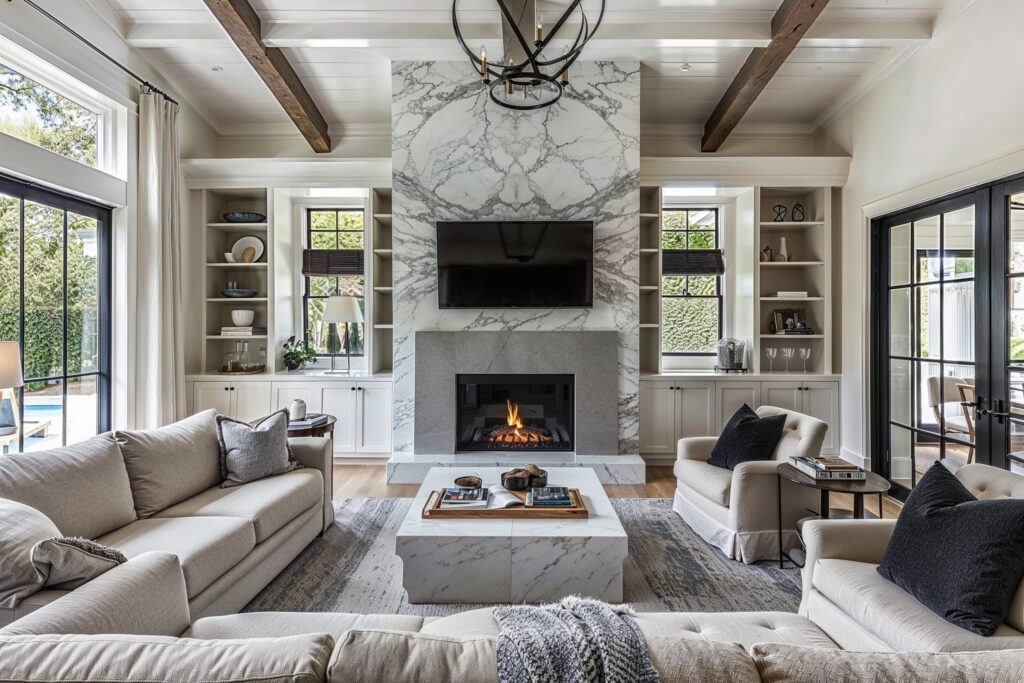In Nepal, the living room is more than just a space—it’s a cultural hub where families gather, guests are welcomed, and traditions blend with contemporary lifestyles. As urbanization and global influences shape design preferences, Nepali homeowners are embracing innovative yet culturally rooted interiors. This guide explores popular styles, current trends, and a detailed cost breakdown to help you design a living room that reflects Nepal’s unique aesthetic and practical needs.
Popular Living Room Styles in Nepal
- Traditional Nepali Design
- Key Elements: Hand-carved wooden furniture, Dhaka fabric cushions, brass accents, and Thangka paintings .
- Cost Impact: Locally sourced wood and traditional craftsmanship can reduce expenses, but intricate carvings and custom pieces may increase costs.
- Modern Minimalist
- Key Elements: Neutral tones (white, beige), clean lines, multifunctional furniture, and ample natural light .
- Cost Impact: Simplicity reduces clutter and expenses, but high-quality minimalist furniture (e.g., modular sofas) can be pricey.
- Contemporary Fusion
- Key Elements: Sleek modern furniture paired with ethnic rugs, traditional woodwork, and statement lighting .
- Cost Impact: Balancing imported modern items with local decor can optimize budgets.
- Sustainable & Biophilic Design
- Key Elements: Bamboo furniture, indoor plants, reclaimed wood, and energy-efficient lighting .
- Cost Impact: Eco-friendly materials like bamboo are affordable, but solar-powered systems may require upfront investment.
2025 Trends Shaping Nepali Living Rooms
- Smart Home Integration
- Automated lighting, voice-controlled appliances, and solar-powered systems are rising in urban areas like Kathmandu .
- Multifunctional Furniture
- Sofa beds, foldable tables, and storage ottomans maximize space in compact homes .
- Earthy Color Palettes
- Terracotta, sage green, and muted ochre dominate, paired with natural textures like stone and clay .
- Cultural Fusion
- Modern spaces adorned with Newari woodwork, Tibetan motifs, and Dhaka textiles .
Detailed Cost Breakdown
Costs vary based on materials, labor, and location (e.g., Kathmandu vs. rural areas).
| Category | Basic (NPR 3–5 lakh) | Mid-Range (NPR 6–10 lakh) | Luxury (NPR 12–25 lakh+) |
|---|---|---|---|
| Furniture | Local wood, simple sofas | Modular designs, upholstered | Imported leather, custom |
| seating | carved pieces | ||
| Lighting | Basic fixtures | Designer pendants, dimmable | Chandeliers, smart systems |
| lights | |||
| Flooring | Ceramic tiles | Engineered wood, textured | Italian marble, heated floors |
| stone | |||
| Wall Treatments | Paint or basic plaster | Textured finishes, wallpaper | Custom stone cladding, |
| murals | |||
| Decor & Accessories | DIY art, local pottery | Thangka paintings, brassware | Imported sculptures, |
| smart mirrors |
Additional Costs:
- Labor: NPR 500–1,000 per sq. ft. for skilled artisans .
- Designer Fees: 10–15% of the total budget for professional services .
Budget-Friendly Tips
- Repurpose Materials: Use reclaimed wood or upcycled furniture for a rustic look .
- DIY Accents: Create wall art or planters using local materials .
- Prioritize Key Areas: Invest in a statement sofa or lighting while saving on decor.
- Local Sourcing: Bamboo, clay, and Dhaka fabrics are affordable and sustainable .
Hiring Professionals vs. DIY
- Pros of Designers: Expertise in space optimization, material sourcing, and avoiding costly errors .
- DIY Approach: Ideal for small updates (e.g., painting, rearranging furniture) but may lack cohesion .
Conclusion
Designing a living room in Nepal is an opportunity to celebrate heritage while embracing modernity. Whether you opt for a traditional Newari-inspired space or a tech-savvy minimalist layout, thoughtful planning and budget alignment ensure a functional and aesthetically pleasing result. By leveraging local craftsmanship and sustainable practices, your living room can become a timeless reflection of Nepal’s evolving design identity.
For more inspiration, explore portfolios from firms like ASDESIGN guides .


